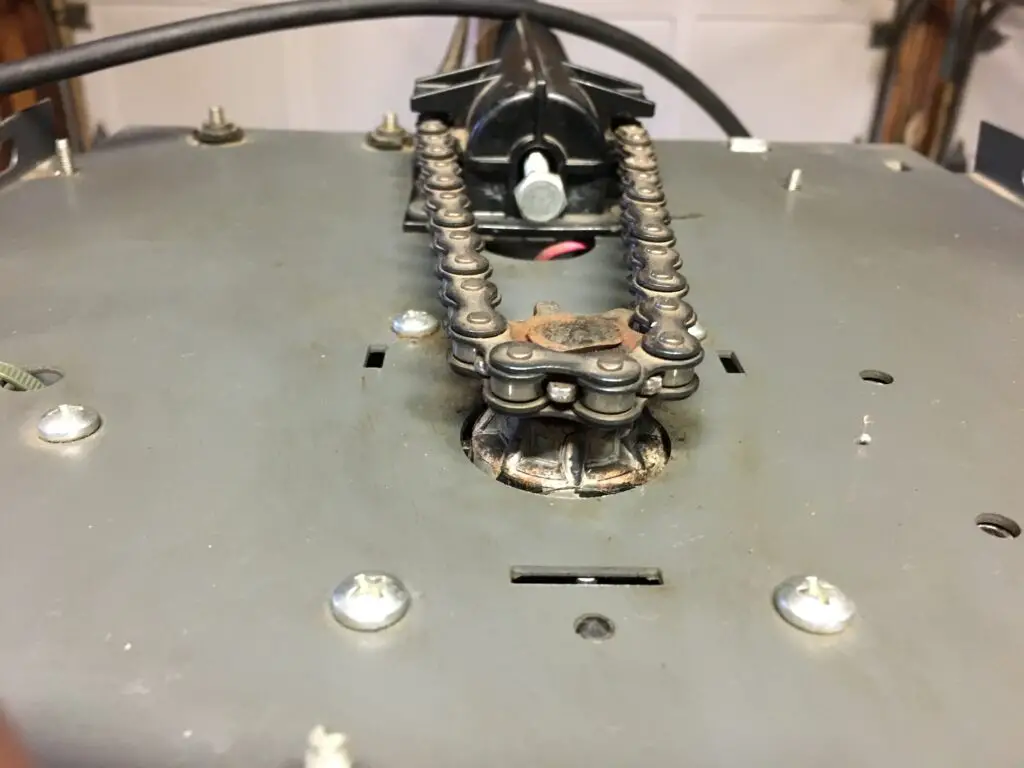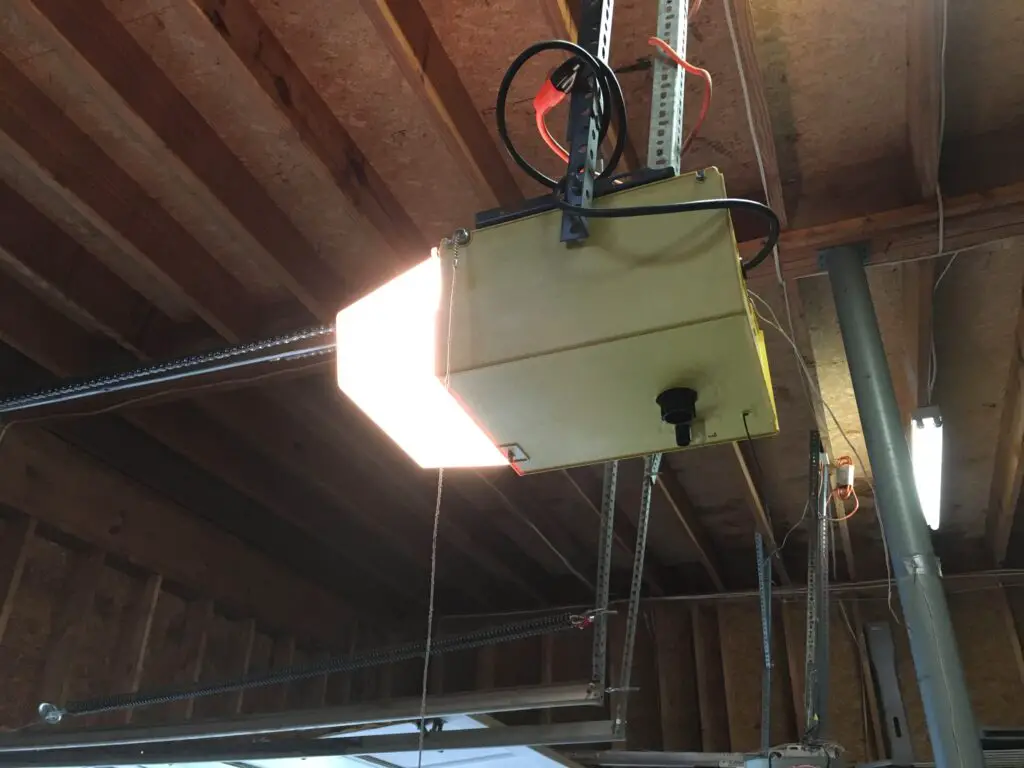Garage door chains come in several different sizes, which must be matched to your opener’s drive in order to fit properly. While different manufacturers use the same type of chain, the chains themselves come in several sizes to fit different weights of garage doors.
The door chains themselves are pretty much universal, however, so you can usually mix and match parts from different vendors.
Not all garage doors use chains. Some use a combination chain and cable system while others use belts.
These alternative designs aren’t interchangeable with the chains that you’d find on other garage door openers.
What Size Chain Do Garage Door Openers Use?
Garage door opener chains are measured in terms of pitch, which is the size of the space between the rollers, and width. Common chain sizes are given ID numbers, which are usually printed on an opener’s label.
Most garage door openers use one of these common sizes:
- Size 80: 5/8″ width, 1″ pitch
- Size 60: 1/2″ width, 3/4″ pitch
- Size 50: 3/8″ width, 5/8″ pitch
- Size 40: 5/16″ width, 1/2″ pitch
- Size 35: 3/18″ width, 3/8″ pitch
- Size 25: 1/8″ width, 1/4″ pitch
A few manufacturers may specify size 41 or 48 chain, which both use a 1/4″ width and a 1/2″ pitch. These aren’t considered normal sizes, but a few companies use them in specialty applications.
Are Garage Door Opener Rails Universal?
Standard lift tracks are universal and used in an overwhelming majority of residential applications. That means for most homeowners, garage door rails are universal and you shouldn’t have any difficulty swapping them out.
These standard lifts consist of little more than a vertical track that rises eight inches or so short of the overall door height. In most garages, this means that they include 6’4″ of straight metal that starts to curve back toward the remainder of a longer horizontal track.
High lift and vertical systems, which are found in auto repair shops, usually have different size specifications so you can’t use them with the standard garage door openers you’d find at a hardware store.
Can I Reuse the Garage Door Rail When Replacing the Garage Door Opener?
Residential garage owners who have a standard track can reuse the door rail without any difficulty. You’ll want to make sure that there’s no rust or other corrosion that could cause damage.
A light amount of corrosion could be removed using a gentle piece of steel wool. Rails with a substantial amount of corrosion cannot usually be trusted, however.
Vertical lift systems in commercial facilities and body shops can usually be reused only if you’re replacing the door opener with another piece of commercial hardware. While you almost never see these in homes, they’re pretty common in businesses and dealerships.
Are Garage Door Openers Interchangeable?
You can replace any garage door opener with another that has the same horsepower motor as the original and expects the same size and type of chain. Homeowners who have a 1/2HP motor will need to get a garage door opener that has a motor that’s as powerful.
More and more garage door opener kits come with a set of gears and adapters so they can latch onto several different sizes of chain. When you shop for another garage door opener, you’ll want to make sure it supports the size of chain you have.
You can replace a motor independently of the rest of the gear if you don’t mind opening up the unit of your housing. Replacing the chain without touching the motor is also just as easy.
Remotes are normally keyed to work with only one garage door opener for security reasons, so you normally can’t interchange these because doing so would allow you to open your neighbor’s garage! Some newer models do allow you to reprogram existing remotes so you don’t have to waste a perfectly good one, however.
Some techie garage door openers can also interface with a smartphone or car-play app, so you wouldn’t even need to worry about syncing up a remote.
How Do You Remove a Link from a Garage Door Chain?
The easiest way to remove a link is with a chain puller. Using firm pressure, hold the teeth of the chain link tool over the area you want removed and then pop the link away from the rest of the chain.
With practice, you should be able to get links off with a single motion. You will need a chain puller that’s correctly sized for your garage door opener’s links, however.
While these tools are relatively inexpensive, you can also remove a link by taking a pair of slotted screwdrivers or small chisels and placing them on either side of the link. By applying pressure evenly to both sides, you can usually get the chain to loosen up.
It’s much better to use a specialized chain breaker, however.
Is Chain or Belt Better for Garage Door Opener?
Belt driven garage door openers are much more durable than chain driven ones. A belt is much better for opening and closing very heavy or large garage doors and they can also open the door much faster than a chain can.
They’re far less common, however, and you might not find one by simply heading over to your local hardware store. Chains are usually more affordable as well.
A belt drive system may cost around $300, though professional grade models will cost over $1,000. By comparison, a chain drive garage door opener won’t normally cost much more than $150-200 if you don’t have to replace the rails.
Why Did My Garage Door Chain Break?
Rust is the most common cause of broken garage door chain links. Over time, oxidization can occur when the chain gets wet, which is why they’re usually coated with some kind of penetrating oil.
Chains normally don’t break otherwise, but the gears and sprockets attached to them do. If your chain wasn’t properly installed or got loose over time, then there’s a good chance that it will eventually snag a sprocket and cause one of your garage door opener’s moving parts to break off.
Low-end garage door openers use a combination of a chain attached to a separate cable, which usually isn’t very sturdy. The cables used in these models can break under too much tension, but the good news is that they’re easily replaced.
Homeowners who find that their garage door opener chains keep breaking should check that they’re using the right size chain and drive for their door. When the weight of a door exceeds the strength of a chain, it might shed its links off.
Troubleshooting
Reader Mike – Sprocket and Chain Making a Lot of Noise
Mike wrote in recently and asked the following
I have an old (1980s) 1/3 hp Stanley opener (model 2500.37) that I decided to get running again after about 10 years of not working. There is a lot of info on these openers on YouTube now, so I thought I would give it a shot (fun!). I replaced the capacitor and the gear casing and everything seems to be proper except I can’t get the chain to mesh to the sprocket correctly, so it makes a lot of noise and shakes as the teeth interact with the chain. Also, the chain doesn’t look level on the sprocket. I have tried different chain tensions and it happens with each. With the chain totally loose it will not mesh with the sprocket. I have included some before and after photos.

HappyHomeQuest’s response…
That chain looks like it’s in good shape but the sprocket is a bit rough looking. Is it a new chain that’s not lining up with the old sprocket?
Another thing it could be is tension. I have a similar issue with my e-bike when I change the rear tube. After putting the tire back on if I’m not careful to pull the rear tire back and get enough tension on the chain it’ll make a lot of noise and slip from time to time.
Sounds like you could be running into a similar problem which could be either from not enough tension (or maybe too much) or just a misalignment from the old sprocket.
First try the tension using this video…
Then maybe try a new sprocket.
Mike’s success…
It’s fixed!
I thought I would try to adjust the sprocket first so I loosened the garage door chain, then loosening the opener’s gear casing screws, and wiggled (actually jerked on) the bottom of the sprocket shaft. I heard a slight pop at the sprocket which I think was one of the teeth seating into the chain. Then I retightened those screws and retightened the opener’s chain a little tighter than before. When test running, the opener was making less noise but still pretty noisy at the start of door lift. I then tightened the chain as described in the video that you provided, slightly higher than the rail, and it now very quiet! The Stanley owner’s manual said to let the chain sag ½” below the rail so I was a little hesitant to tighten it much more. But the owner’s manual’s instruction was with the opener in a different configuration (rail attached above door and motor on the floor – less rail sag). Anyway, I feel confident that it is correct the way I have it now. The chain is slightly higher than the rail on the tight side and with a little sag on the other side. Tightening the chain was probably all I needed to do!
FYI, I also got a Genie GIRUD-1T receiver with remote so that I can operate the door from our car’s built-in garage door controller and that is working well. I also plan to get a smart home plug (I use Caseta) for the opener so that I can disable it when needed for security.
Thank you for your help with this! I’m so proud to get this old opener working again!
Mike
Happy working garage door opener…

